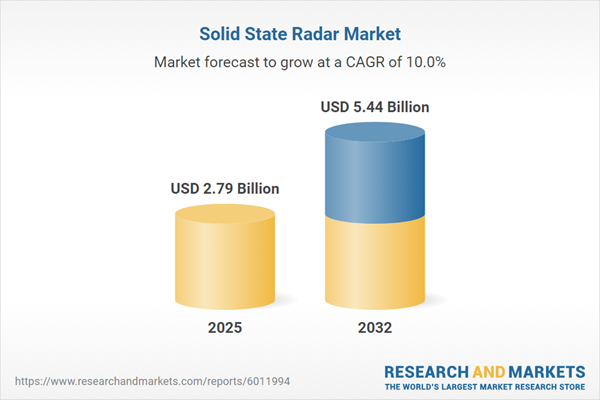Speak directly to the analyst to clarify any post sales queries you may have.
Solid state radar technologies are redefining the landscape of modern sensing, offering highly reliable and precise solutions across critical industries. As organizations navigate technological and regulatory shifts, understanding these market dynamics is essential for informed decision-making and competitive advantage.
Market Snapshot: Growth Trends in the Solid State Radar Market
The solid state radar market is on a robust upward trajectory with significant revenue growth forecasted through 2032. Driven by advances in semiconductor materials, shrinking form factors, and strong demand in sectors such as automotive, defense, and infrastructure monitoring, the market’s sustained expansion is supported by rapid innovation. The increasing deployment of solid state radar in applications that require high reliability and low maintenance is a defining market trend, positioning this technology as an essential foundation for next-generation sensing systems.
Scope & Segmentation of the Solid State Radar Market
This comprehensive report covers major dimensions and critical segmentation areas to equip decision-makers with actionable intelligence:
- Application Areas: Advanced driver assistance, autonomous vehicles, air traffic control, collision avoidance, missile defense, surveillance and reconnaissance, target acquisition, maritime monitoring (coastal and shipborne), and weather surveillance (conventional and Doppler).
- Platform Types: Manned aircraft, unmanned aerial systems, ground-based fixed and mobile solutions, surface and submarine naval installations, and satellite-borne systems.
- Technological Approaches: Gallium arsenide, gallium nitride, and silicon germanium devices, supporting a balance of performance, cost effectiveness, and application-specific requirements.
- Frequency Bands: C Band, Ka Band, Ku Band, L Band, S Band, and X Band, each tailored for specific resolution and range needs across multiple operational environments.
- Core Components: Antennas, receivers, signal processors, and transmitters, forming the building blocks for modular and custom radar solutions.
- Regional Coverage: North America (United States, Canada, Mexico), Latin America (Brazil, Argentina, Chile, Colombia, Peru), Europe (United Kingdom, Germany, France, Russia, Italy, Spain, Netherlands, Sweden, Poland, Switzerland), Middle East (UAE, Saudi Arabia, Qatar, Turkey, Israel), Africa (South Africa, Nigeria, Egypt, Kenya), and Asia-Pacific (China, India, Japan, Australia, South Korea, Indonesia, Thailand, Malaysia, Singapore, Taiwan).
- Key Company Profiles: Raytheon Technologies, Northrop Grumman, Lockheed Martin, BAE Systems, Thales, Leonardo, Saab, Hensoldt, Mitsubishi Electric, and Indra Sistemas.
Key Takeaways: Strategic Insights for Decision-Makers
- Solid state radar is rapidly establishing itself as the platform of choice for industries requiring dependable, low-maintenance sensing solutions, particularly in mission critical defense, aviation, weather, and maritime applications.
- Sustained semiconductor advancements enable improved resolution and environmental survivability, supporting adaptation to complex operating requirements and expanding use cases in both established and emerging sectors.
- Integration with machine learning is enhancing radar accuracy and reducing false alarms, enabling adoption in areas like collision avoidance, advanced surveillance, and networked sensor grids.
- The convergence between traditional defense contractors and technology firms is accelerating the commercialization of military-grade innovations, resulting in faster development cycles and field reconfigurable radar architectures.
- Regional market dynamics reflect varying priorities: Americas advance through defense and traffic safety investments; Europe, Middle East, and Africa adopt radar for civil aviation and coastal protection programs; Asia-Pacific’s growth centers on infrastructure and expanding maritime and space initiatives.
Tariff Impact on the Solid State Radar Supply Chain
Recent U.S. trade tariffs have introduced new procurement and cost variables for the solid state radar industry. Increased duties on semiconductor components have prompted manufacturers to diversify sourcing and invest in domestic production, driving broader industry realignment. These measures also encourage closer cross-border partnerships and innovation strategies to maintain supply chain resilience against ongoing policy fluctuations.
Methodology & Data Sources
This report utilizes a multi-pronged approach: expert consultations, secondary data evaluation of technical and regulatory literature, and reviews of market-leading patents. Validation included workshops with domain experts and scenario modeling for policy and supply chain assessments, supporting consistently robust and credible findings.
Why This Report Matters for Solid State Radar Market Strategy
- Supports strategic planning by clarifying key growth drivers and technological advancements influencing the solid state radar market.
- Provides a granular breakdown of applications, platforms, and regional trends to inform investment, production, and partnership decisions.
- Delivers actionable intelligence on adapting to supply chain disruptions, emerging partnership opportunities, and regulatory changes that may impact growth and competitiveness.
Conclusion
The evolution of solid state radar is reshaping sensing applications across sectors. Organizations aligning technology, supply chain, and market strategies will enhance resilience and capture emerging opportunities in this dynamic field.
Additional Product Information:
- Purchase of this report includes 1 year online access with quarterly updates.
- This report can be updated on request. Please contact our Customer Experience team using the Ask a Question widget on our website.
Table of Contents
3. Executive Summary
4. Market Overview
7. Cumulative Impact of Artificial Intelligence 2025
List of Figures
Samples

LOADING...
Companies Mentioned
The key companies profiled in this Solid State Radar market report include:- Raytheon Technologies Corporation
- Northrop Grumman Corporation
- Lockheed Martin Corporation
- BAE Systems plc
- Thales S.A.
- Leonardo S.p.A
- Saab AB
- Hensoldt AG
- Mitsubishi Electric Corporation
- Indra Sistemas, S.A.
Table Information
| Report Attribute | Details |
|---|---|
| No. of Pages | 189 |
| Published | October 2025 |
| Forecast Period | 2025 - 2032 |
| Estimated Market Value ( USD | $ 2.79 Billion |
| Forecasted Market Value ( USD | $ 5.44 Billion |
| Compound Annual Growth Rate | 9.9% |
| Regions Covered | Global |
| No. of Companies Mentioned | 11 |









